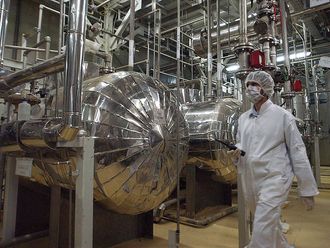Washington: A candid memoir by former US Defence Secretary Ash Carter provides a rare opportunity to better understand President Barack Obama’s Syria strategy before it recedes into the historical distance. His many valuable insights raise one big question, however: Why did the US even get involved?
The apparent goal of Carter’s detailed reminiscences is to establish his role in the defeat of Daesh. The former defence secretary asserts that effective operations against Daesh and a specific battle plan, which Carter claims US and allied forces still follow (the two “red arrows” pointing toward Mosul and Raqqa), only took shape after his appointment in February 2015. But, the self-serving part aside, Carter’s 45-page report describes an effort that had few supporters in the region it affected.
Carter blames the US withdrawal from Iraq for the emergence of Daesh. But even after the terror militia set up its “state,” “the people of the region did not want invasion-sized forces to return,” the ex-secretary recalls. Throughout his two-year tenure, Carter had to “ease [Iraqi] Prime Minister [Haider Al Abadi] into accepting more US forces (which was controversial for him at home).” The Iraqi forces, too, initially were reluctant to fight, to the open irritation of Carter and US generals who had to keep prodding the Iraqis into action.
Obviously, the Syrian government of President Bashar Al Assad was even less welcoming of US intervention, even when the US administration’s idea was to set up local anti-Daesh forces from scratch “by recruiting individual fighters, forming them into units, providing them training and equipment in Turkey and Jordan, and re-inserting them into the fight in Syria.” Even though, as Carter explains, the idea was that these fighters wouldn’t get involved in the Syrian civil war, Assad was well aware of what the US thought of him. Then, Carter came in and changed the plan, switching US support to existing paramilitary formations. “Almost all the real fighters were already part of ad hoc groups and all wanted to fight Assad as well as Daesh,” he explains.
It was after the US decided that this was OK that Assad made his case to Russian President Vladimir Putin. What Putin saw was US interference in the civil war, an attempt at regime change — something he had vehemently opposed in Libya, even quarrelling with then-President Dmitri Medvedev, who had allowed the Western interference there to go unchallenged. By arming and training anti-Assad groups, the Obama administration — and Carter personally if indeed it was he who brought about the change of strategy — drew Russia into the conflict.
After Putin began the Russian operation in September 2015, Carter recalls persistent Russian efforts to establish a pattern of cooperation with the US. “From that first moment, Russia sought to associate us and the counter-Daesh campaign with what they were doing in Syria — constantly telling the world of their desire to coordinate and cooperate with us, asking to share targeting and intelligence information,” Carter wrote. He rebuffed these advances for three main reasons. First, coordinating with Russia, which was closely allied with Iran in Syria, could have weakened Iraqi Prime Minister Abadi’s resolve to work with the US. Next, it could link the US to the “inhuman” Russian campaign (a questionable reason at best given the multiple civilian casualties inflicted by the US-led coalition). Finally — and I think most importantly for the Obama administration — “it would naively grant Russia an undeserved leadership role in the Middle East.”
Unsatisfactory interactions with Russia, and Carter’s struggle to stop John Kerry’s State Department from making a deal with Putin that would involve military coordination rather than mere deconfliction, are described in a chapter about “spoilers and fence-sitters.” Apart from Russia and Iran, these include Turkey — which, according to the ex-secretary, “caused the most complications for the campaign” — and the Arab neighbourhood, the Gulf states, which, Carter writes, “were active in lobbying and PR that somehow never translated into battlefield action.”
To sum up, US interests weren’t clearly aligned with: Iraq, Iran, Russia, Turkey, the Assad government in Syria and the Gulf states. Did the US have any enthusiastic allies at all?
Well, there were some of the anti-Assad rebels (except the ones wedded to Islamist causes) and, most of all, the Kurds. US support of them, of course, was the main reason Turkey turned from an ally into a “spoiler.” But at least someone really wanted the US to be involved, if for reasons that had less to do with Daesh than with the Kurdish dream of a sovereign state. Now, the Kurds of Iraq have voted for independence, justifying all the misgivings Abadi had about the US’ anti-Daesh operation.
In fighting Daesh, the US managed to step on everybody’s toes in a battered, short-fused region that was already leery of US interference after the Iraq and Libya adventures. Carter’s account sheds light on how that happened, as much as into the mechanics of defeating Daesh. It explains why peace in the region won’t be a given even after the Daesh is gone: Carter himself writes that he’s concerned “the international community’s stabilisation and governance efforts will lag behind the military campaign.” The account also raises the question whether a more lasting solution could have been achieved if Assad and his allies on the one hand and Turkey on the other had been left to deal with the Daesh problem without US. interference.
Counterfactuals, however, are useless. The US involvement has only intensified after the Obama administration left, and political stability in Syria and Iraq is ever more elusive as Middle Eastern nations and armed groups try to get used to the US/Russia/Turkey triangle of power brokers. Carter can proudly claim a part in bringing about this new, volatile configuration.











